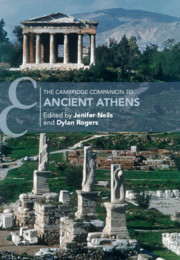Book contents
- The Cambridge Companion to Ancient Athens
- Cambridge Companions to the Ancient World
- The Cambridge Companion to Ancient Athens
- Copyright page
- Contents
- Contributors
- Abbreviations
- Athens: An Introduction
- 1 #Leagros: An Athenian Life
- Part I The Urban Fabric
- 2 Asty and Chora: City and Countryside
- 3 The Emergence of the Polis
- 4 City Streets, Walls, and Gates
- 5 The Akropolis
- 6 The Agora: Public Life and Administration
- 7 Athenian Inscriptions
- 8 Water and Water Management
- 9 Housing and the Household
- 10 The Archaic and Classical Cemeteries
- Part II Inhabitants
- Part III Business/Commerce
- Part IV Culture and Sport
- Part V Politics
- Reception
- Index
- References
8 - Water and Water Management
from Part I - The Urban Fabric
Published online by Cambridge University Press: 10 March 2021
- The Cambridge Companion to Ancient Athens
- Cambridge Companions to the Ancient World
- The Cambridge Companion to Ancient Athens
- Copyright page
- Contents
- Contributors
- Abbreviations
- Athens: An Introduction
- 1 #Leagros: An Athenian Life
- Part I The Urban Fabric
- 2 Asty and Chora: City and Countryside
- 3 The Emergence of the Polis
- 4 City Streets, Walls, and Gates
- 5 The Akropolis
- 6 The Agora: Public Life and Administration
- 7 Athenian Inscriptions
- 8 Water and Water Management
- 9 Housing and the Household
- 10 The Archaic and Classical Cemeteries
- Part II Inhabitants
- Part III Business/Commerce
- Part IV Culture and Sport
- Part V Politics
- Reception
- Index
- References
Summary
This chapter explores water management in ancient Athens, including the local climate and natural resources of water in the city, underground water installations (e.g. wells, cisterns, aqueducts, and drains), and fountain-houses and bathing facilities. The archaeological evidence is supplemented by inscriptions and ancient texts referring to water legislation, illustrating the role of water in cult and in many other aspects of everyday life.
- Type
- Chapter
- Information
- The Cambridge Companion to Ancient Athens , pp. 110 - 123Publisher: Cambridge University PressPrint publication year: 2021
References
Further Reading
For more on springs, rivers, and nymphs of Athens, see Ammermann 1996, Brewster 1997, Larson 2001, and Kypraiou 2004. On the water supply of Athens, consult Camp 1977 and Chiotis 2011. For more on wells and cisterns throughout the city, see Klingborg 2017 and Stroszeck 2017. Glaser 1983 and Longfellow 2011 (9–13) offer good overviews of Greek fountains and fountain-houses, along with Paga 2015 on the Southeast Fountain-House of the Agora. For more on Greek bathing, see Lucore and Trümper 2013. On fountains of Roman Athens, see Longfellow 2011 and Leigh 2018, with bibliography therein. See Christaki et al. 2017 for a discussion of Athenian water supply until the nineteenth century ad.
Bibliography
Additional resources to accompany this chapter can be found at: www.cambridge.org/NeilsRogers



